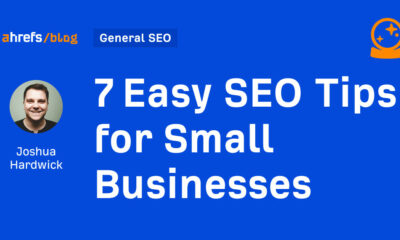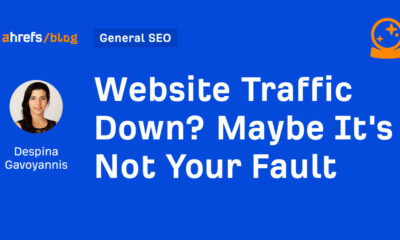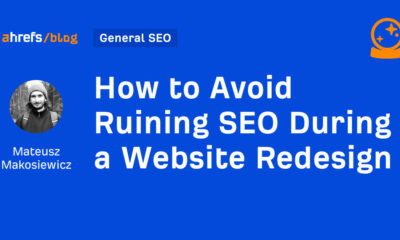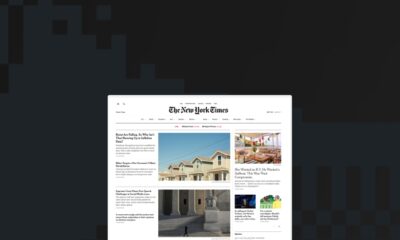MARKETING
11 Website Copywriting Tips to Increase Conversions in 2022

A 2022 State of Content Marketing report by SEMrush revealed that 40% of brands surveyed say they outsource copywriting. If you fall in the 60% and want to improve your copywriting skills, we’re here to help.
Web copy can make the difference between a visitor and a lead. It plays an integral role for consumers at every stage of the buying cycle, from awareness to decision making and advocacy.
Below, you’ll find tips on how to write compelling copy.
What is website copywriting?
Website copywriting is the process of writing content – think blog posts, landing pages, product pages – to prompt a desired action on a website. Well-crafted website copy can turn visitors into leads and leads into customers.
Most marketers can identify poor web copy when they see it. Why? Because poor web copy doesn’t read smoothly, stir emotions, influence behaviors, or make explicit calls to action.
It feels purposeless — and that’s the exact opposite of what marketing is meant to accomplish.
Yet, web copywriting is a strategy that sometimes falls by the wayside, often overlooked for other website elements like SEO, design, and functionality.
13 Website Copywriting Tips for Increasing Conversions
- Know your audience.
- Figure out the why.
- Complexity kills readability.
- Be concise.
- Write how you speak.
- Take breaks between drafts.
- Break up the copy.
- Avoid overuse of buzzwords.
- Focus on benefits.
- Don’t overlook microcopy.
- Check out the competition.
1. Know your audience.
The number one tip for website copywriting is to know who will be reading it. If you don’t have a reader in mind, how will you know which words and tone will resonate with them best?
As a writer myself, I am constantly aware of the user and their needs. It’s my north star when writing posts. How did I get to know them? Through user personas and data.
User personas will tell you who is the average reader landing on my article, what their pain points and challenges are, along with their goals. Data will give you insight into what strategies have performed well with that audience and which ones to stay away from.
With both, you’ll gain a deeper understanding of your audience, which will allow you to write copy that will engage and compel your user to take action.
2. Figure out the why.
You’ve been tasked with writing a particular piece of copy on the company website.
Once you understand your audience, one HubSpot marketer recommends asking yourself, “who cares?”
“If I can’t answer that, then I can’t expect anyone to read it,” said Curtis del Principe, SEO content writer at HubSpot. “Once I have an idea of who cares (and why), then I have an angle and a through line to guide my writing.”

Too often, we write without diving into the purpose of the content. What will the reader gain from reading this? What do I want them to do after reading this? Why should they care about this content?
Answering these questions is key to writing valuable content.
3. Complexity kills readability.
SEMrush recently analyzed over 23,561 texts ranking in Google’s top 10 results. They found that the lowest-scoring texts had two things in common: They were too long or too complex.
In fact, 41% of low-scoring texts used words that were too complex.
Take this as your sign to skip the jargon and the fancy words – just get straight to the point. Here are a few examples:
- Helpful vs. Beneficial
- Use vs. Utilize
- Happen vs. Occur
- Test vs. Examine
When in doubt, keep it simple.
4. Be concise.
Nobel prize winner and writer William Faulkner said it best: Kill your darlings.
As writers, it’s so easy to get carried away with our words. In marketing, using excessive language can have the exact opposite effect.
AJ Beltis, senior marketing manager at HubSpot responsible for blog leads, calls himself a wordy writer. So, he focuses on brevity.
“The first time I write something, I get all of my thoughts down in writing. Then, I’ll look it over again, and ask myself, “how can I say this more concisely?” he says. “I find that I’m able to get my point across clearer and faster as a result.”

Madison Z. Vettorino echoes this by encouraging brands to keep their copy “bite-sized” without sacrificing accuracy and authenticity.
“Every word and sentence should connect to that core idea. If it doesn’t, it’s unnecessary and should be deleted,” she says. “When it comes to copywriting, the ability to keep it brief yet impactful is a superpower.”
5. Write how you speak.
This one seems obvious but can be the biggest hurdle for copywriters.
We often think that our readers use language that’s more advanced and elevated than our own. But the truth is, many readers want to be spoken to like a friend.
“It’s more relatable and conversational, and the reader gets a little taste of your personality,” says HubSpot staff writer Alana Chinn. “Plus, it’s a lot easier to write about complex topics if you think about how you’d explain them to a friend or family member in real life.”

6. Take breaks between drafts.
When you’ve been working on something for a while, it becomes hard to spot errors.
To combat this, take a lot of time between edits, says HubSpot staff writer Madhu Murali.
“This gives me a fresh perspective on the piece each time I read it and get a better idea of a reader’s POV,” he says.
When rereading, you’ll likely spot clunky sentences, awkward phrasing, and grammar mistakes more easily. This approach can turn good copy into great copy.
7. Break up the copy.
No matter how good your copy is, if it’s long and bulky, you’re likely to lose your reader’s attention.
Eye-tracking studies reveal that website visitors often skim articles instead of reading every sentence. As such, break up your paragraphs – especially if your traffic mostly comes from mobile devices.
This can be also done through subheaders, bullet points, and images, as shown in the example below.

8. Avoid overuse of buzzwords.
I once landed on a website and read so many buzzwords that I had no idea what they were saying. I spent a few minutes re-reading sentences to make sense of them but got nowhere.
I got discouraged and exited the site.
When using buzzwords, the goal is usually to use words most likely to stand out to readers. Sometimes, people get carried away a bit and you end up with a convoluted sentence with no substance.
In this case, less is more. So, keep your copy straightforward and jargon-free – unless you have data to prove that it works for your audience.
9. Focus on benefits.
As straightforward as this seems, many companies fail to apply this principle to their web copy.
They focus on what their company does and what products they offer, instead of writing from the reader’s perspective. What can they gain from using your software? Start from there.
So, instead of saying “We do inbound marketing,” try something like “Increase your web traffic and leads with engaging content,” which immediately outlines the benefits.
10. Don’t overlook microcopy.
Microcopy refers to short text on a website, such as a call to action and the label on a form field.
the text that doesn’t seem to come up in conversation very often, but it’s little details like these that can make or break the user experience on your website.

Easier said than done, right? We know.
There are a few surefire ways to write an engaging CTA:
- Use action verbs – Instead of generic phrases like “Click here” and “Learn more,” use terms like “discover,” “join,” instead of generic phrases like “click here.”
- Appeal to their desires – If you know your audience seeks community, you can emphasize this with a CTA like “Join a community of 1,000+ marketers.”
- Evoke urgency and scarcity – Terms like “limited,” “Act now,” and “while it lasts,” can drive action from consumers who don’t want to miss out.
11. Check out the competition.
It’s always helpful seeing what your competitors are doing, as it can inform your own strategy. Copywriting is no different.
Review your direct competitors’ websites and take note of their copy. What’s their tone? How do they present their products and services to consumers? What CTAs do they use (and on which pages) to drive traffic through to the bottom of the funnel?
I’m not suggesting that you should adopt their copywriting approach but it doesn’t hurt to know their take.
Now that you have all these tips, you can step your copywriting game up and increase those conversions.
Editor’s Note: This post was originally published in March 2015 and has been updated for comprehensiveness.
MARKETING
Tinuiti Marketing Analytics Recognized by Forrester

Rapid Media Mix Modeling and Proprietary Tech Transform Brand Performance
Tinuiti, the largest independent full-funnel performance marketing agency, has been included in a recent Forrester Research report titled, “The Marketing Analytics Landscape, Q2 2024.” This report comprehensively overviews marketing analytics markets, use cases, and capabilities. B2C marketing leaders can use this research by Principal Analyst Tina Moffett to understand the intersection of marketing analytics capabilities and use cases to determine the vendor or service provider best positioned for their analytics and insights needs. Moffett describes the top marketing analytics markets as advertising agencies, marketing dashboards and business intelligence tools, marketing measurement and optimization platforms and service providers, and media analytics tools.
As an advertising agency, we believe Tinuiti is uniquely positioned to manage advertising campaigns for brands including buying, targeting, and measurement. Our proprietary measurement technology, Bliss Point by Tinuiti, allows us to measure the optimal level of investment to maximize impact and efficiency. According to the Forrester report, “only 30% of B2C marketing decision-makers say their organization uses marketing or media mix modeling (MMM),” so having a partner that knows, embraces, and utilizes MMM is important. As Tina astutely explains, data-driven agencies have amplified their marketing analytics competencies with data science expertise; and proprietary tools; and tailored their marketing analytics techniques based on industry, business, and data challenges.
Our Rapid Media Mix Modeling sets a new standard in the market with its exceptional speed, precision, and transparency. Our patented tech includes Rapid Media Mix Modeling, Always-on Incrementality, Brand Equity, Creative Insights, and Forecasting – it will get you to your Marketing Bliss Point in each channel, across your entire media mix, and your overall brand performance.
As a marketing leader you may ask yourself:
- How much of our marketing budget should we allocate to driving store traffic versus e-commerce traffic?
- How should we allocate our budget by channel to generate the most traffic and revenue possible?
- How many customers did we acquire in a specific region with our media spend?
- What is the impact of seasonality on our media mix?
- How should we adjust our budget accordingly?
- What is the optimal marketing channel mix to maximize brand awareness?
These are just a few of the questions that Bliss Point by Tinuiti can help you answer.
Learn more about our customer-obsessed, product-enabled, and fully integrated approach and how we’ve helped fuel full-funnel outcomes for the world’s most digital-forward brands like Poppi & Toms.
The Landscape report is available online to Forrester customers or for purchase here.
MARKETING
Ecommerce evolution: Blurring the lines between B2B and B2C

Understanding convergence
B2B and B2C ecommerce are two distinct models of online selling. B2B ecommerce is between businesses, such as wholesalers, distributors, and manufacturers. B2C ecommerce refers to transactions between businesses like retailers and consumer brands, directly to individual shoppers.
However, in recent years, the boundaries between these two models have started to fade. This is known as the convergence between B2B and B2C ecommerce and how they are becoming more similar and integrated.
Source: White Paper: The evolution of the B2B Consumer Buyer (ClientPoint, Jan 2024)
What’s driving this change?
Ever increasing customer expectations
Customers today expect the same level of convenience, speed, and personalization in their B2B transactions as they do in their B2C interactions. B2B buyers are increasingly influenced by their B2C experiences. They want research, compare, and purchase products online, seamlessly transitioning between devices and channels. They also prefer to research and purchase online, using multiple devices and channels.
Forrester, 68% of buyers prefer to research on their own, online . Customers today expect the same level of convenience, speed, and personalization in their B2B transactions as they do in their B2C interactions. B2B buyers are increasingly influenced by their B2C experiences. They want research, compare, and purchase products online, seamlessly transitioning between devices and channels. They also prefer to research and purchase online, using multiple devices and channels
Technology and omnichannel strategies
Technology enables B2B and B2C ecommerce platforms to offer more features and functionalities, such as mobile optimization, chatbots, AI, and augmented reality. Omnichannel strategies allow B2B and B2C ecommerce businesses to provide a seamless and consistent customer experience across different touchpoints, such as websites, social media, email, and physical stores.
However, with every great leap forward comes its own set of challenges. The convergence of B2B and B2C markets means increased competition. Businesses now not only have to compete with their traditional rivals, but also with new entrants and disruptors from different sectors. For example, Amazon Business, a B2B ecommerce platform, has become a major threat to many B2B ecommerce businesses, as it offers a wide range of products, low prices, and fast delivery
“Amazon Business has proven that B2B ecommerce can leverage popular B2C-like functionality” argues Joe Albrecht, CEO / Managing Partner, Xngage. . With features like Subscribe-and-Save (auto-replenishment), one-click buying, and curated assortments by job role or work location, they make it easy for B2B buyers to go to their website and never leave. Plus, with exceptional customer service and promotional incentives like Amazon Business Prime Days, they have created a reinforcing loyalty loop.
And yet, according to Barron’s, Amazon Business is only expected to capture 1.5% of the $5.7 Trillion addressable business market by 2025. If other B2B companies can truly become digital-first organizations, they can compete and win in this fragmented space, too.”
If other B2B companies can truly become digital-first organizations, they can also compete and win in this fragmented space
Joe AlbrechtCEO/Managing Partner, XNGAGE
Increasing complexity
Another challenge is the increased complexity and cost of managing a converging ecommerce business. Businesses have to deal with different customer segments, requirements, and expectations, which may require different strategies, processes, and systems. For instance, B2B ecommerce businesses may have to handle more complex transactions, such as bulk orders, contract negotiations, and invoicing, while B2C ecommerce businesses may have to handle more customer service, returns, and loyalty programs. Moreover, B2B and B2C ecommerce businesses must invest in technology and infrastructure to support their convergence efforts, which may increase their operational and maintenance costs.
How to win
Here are a few ways companies can get ahead of the game:
Adopt B2C-like features in B2B platforms
User-friendly design, easy navigation, product reviews, personalization, recommendations, and ratings can help B2B ecommerce businesses to attract and retain more customers, as well as to increase their conversion and retention rates.
According to McKinsey, ecommerce businesses that offer B2C-like features like personalization can increase their revenues by 15% and reduce their costs by 20%. You can do this through personalization of your website with tools like Product Recommendations that help suggest related products to increase sales.
Focus on personalization and customer experience
B2B and B2C ecommerce businesses need to understand their customers’ needs, preferences, and behaviors, and tailor their offerings and interactions accordingly. Personalization and customer experience can help B2B and B2C ecommerce businesses to increase customer satisfaction, loyalty, and advocacy, as well as to improve their brand reputation and competitive advantage. According to a Salesforce report, 88% of customers say that the experience a company provides is as important as its products or services.
Market based on customer insights
Data and analytics can help B2B and B2C ecommerce businesses to gain insights into their customers, markets, competitors, and performance, and to optimize their strategies and operations accordingly. Data and analytics can also help B2B and B2C ecommerce businesses to identify new opportunities, trends, and innovations, and to anticipate and respond to customer needs and expectations. According to McKinsey, data-driven organizations are 23 times more likely to acquire customers, six times more likely to retain customers, and 19 times more likely to be profitable.
What’s next?
The convergence of B2B and B2C ecommerce is not a temporary phenomenon, but a long-term trend that will continue to shape the future of ecommerce. According to Statista, the global B2B ecommerce market is expected to reach $20.9 trillion by 2027, surpassing the B2C ecommerce market, which is expected to reach $10.5 trillion by 2027. Moreover, the report predicts that the convergence of B2B and B2C ecommerce will create new business models, such as B2B2C, B2A (business to anyone), and C2B (consumer to business).
Therefore, B2B and B2C ecommerce businesses need to prepare for the converging ecommerce landscape and take advantage of the opportunities and challenges it presents. Here are some recommendations for B2B and B2C ecommerce businesses to navigate the converging landscape:
- Conduct a thorough analysis of your customers, competitors, and market, and identify the gaps and opportunities for convergence.
- Develop a clear vision and strategy for convergence, and align your goals, objectives, and metrics with it.
- Invest in technology and infrastructure that can support your convergence efforts, such as cloud, mobile, AI, and omnichannel platforms.
- Implement B2C-like features in your B2B platforms, and vice versa, to enhance your customer experience and satisfaction.
- Personalize your offerings and interactions with your customers, and provide them with relevant and valuable content and solutions.
- Leverage data and analytics to optimize your performance and decision making, and to innovate and differentiate your business.
- Collaborate and partner with other B2B and B2C ecommerce businesses, as well as with other stakeholders, such as suppliers, distributors, and customers, to create value and synergy.
- Monitor and evaluate your convergence efforts, and adapt and improve them as needed.
By following these recommendations, B2B and B2C ecommerce businesses can bridge the gap between their models and create a more integrated and seamless ecommerce experience for their customers and themselves.
MARKETING
Streamlining Processes for Increased Efficiency and Results

How can businesses succeed nowadays when technology rules? With competition getting tougher and customers changing their preferences often, it’s a challenge. But using marketing automation can help make things easier and get better results. And in the future, it’s going to be even more important for all kinds of businesses.
So, let’s discuss how businesses can leverage marketing automation to stay ahead and thrive.
Benefits of automation marketing automation to boost your efforts
First, let’s explore the benefits of marketing automation to supercharge your efforts:
Marketing automation simplifies repetitive tasks, saving time and effort.
With automated workflows, processes become more efficient, leading to better productivity. For instance, automation not only streamlines tasks like email campaigns but also optimizes website speed, ensuring a seamless user experience. A faster website not only enhances customer satisfaction but also positively impacts search engine rankings, driving more organic traffic and ultimately boosting conversions.
Automation allows for precise targeting, reaching the right audience with personalized messages.
With automated workflows, processes become more efficient, leading to better productivity. A great example of automated workflow is Pipedrive & WhatsApp Integration in which an automated welcome message pops up on their WhatsApp
within seconds once a potential customer expresses interest in your business.
Increases ROI
By optimizing campaigns and reducing manual labor, automation can significantly improve return on investment.
Leveraging automation enables businesses to scale their marketing efforts effectively, driving growth and success. Additionally, incorporating lead scoring into automated marketing processes can streamline the identification of high-potential prospects, further optimizing resource allocation and maximizing conversion rates.
Harnessing the power of marketing automation can revolutionize your marketing strategy, leading to increased efficiency, higher returns, and sustainable growth in today’s competitive market. So, why wait? Start automating your marketing efforts today and propel your business to new heights, moreover if you have just learned ways on how to create an online business
How marketing automation can simplify operations and increase efficiency
Understanding the Change
Marketing automation has evolved significantly over time, from basic email marketing campaigns to sophisticated platforms that can manage entire marketing strategies. This progress has been fueled by advances in technology, particularly artificial intelligence (AI) and machine learning, making automation smarter and more adaptable.
One of the main reasons for this shift is the vast amount of data available to marketers today. From understanding customer demographics to analyzing behavior, the sheer volume of data is staggering. Marketing automation platforms use this data to create highly personalized and targeted campaigns, allowing businesses to connect with their audience on a deeper level.
The Emergence of AI-Powered Automation
In the future, AI-powered automation will play an even bigger role in marketing strategies. AI algorithms can analyze huge amounts of data in real-time, helping marketers identify trends, predict consumer behavior, and optimize campaigns as they go. This agility and responsiveness are crucial in today’s fast-moving digital world, where opportunities come and go in the blink of an eye. For example, we’re witnessing the rise of AI-based tools from AI website builders, to AI logo generators and even more, showing that we’re competing with time and efficiency.
Combining AI-powered automation with WordPress management services streamlines marketing efforts, enabling quick adaptation to changing trends and efficient management of online presence.
Moreover, AI can take care of routine tasks like content creation, scheduling, and testing, giving marketers more time to focus on strategic activities. By automating these repetitive tasks, businesses can work more efficiently, leading to better outcomes. AI can create social media ads tailored to specific demographics and preferences, ensuring that the content resonates with the target audience. With the help of an AI ad maker tool, businesses can efficiently produce high-quality advertisements that drive engagement and conversions across various social media platforms.
Personalization on a Large Scale
Personalization has always been important in marketing, and automation is making it possible on a larger scale. By using AI and machine learning, marketers can create tailored experiences for each customer based on their preferences, behaviors, and past interactions with the brand.
This level of personalization not only boosts customer satisfaction but also increases engagement and loyalty. When consumers feel understood and valued, they are more likely to become loyal customers and brand advocates. As automation technology continues to evolve, we can expect personalization to become even more advanced, enabling businesses to forge deeper connections with their audience. As your company has tiny homes for sale California, personalized experiences will ensure each customer finds their perfect fit, fostering lasting connections.
Integration Across Channels
Another trend shaping the future of marketing automation is the integration of multiple channels into a cohesive strategy. Today’s consumers interact with brands across various touchpoints, from social media and email to websites and mobile apps. Marketing automation platforms that can seamlessly integrate these channels and deliver consistent messaging will have a competitive edge. When creating a comparison website it’s important to ensure that the platform effectively aggregates data from diverse sources and presents it in a user-friendly manner, empowering consumers to make informed decisions.
Omni-channel integration not only betters the customer experience but also provides marketers with a comprehensive view of the customer journey. By tracking interactions across channels, businesses can gain valuable insights into how consumers engage with their brand, allowing them to refine their marketing strategies for maximum impact. Lastly, integrating SEO services into omni-channel strategies boosts visibility and helps businesses better understand and engage with their customers across different platforms.
The Human Element
While automation offers many benefits, it’s crucial not to overlook the human aspect of marketing. Despite advances in AI and machine learning, there are still elements of marketing that require human creativity, empathy, and strategic thinking.
Successful marketing automation strikes a balance between technology and human expertise. By using automation to handle routine tasks and data analysis, marketers can focus on what they do best – storytelling, building relationships, and driving innovation.
Conclusion
The future of marketing automation looks promising, offering improved efficiency and results for businesses of all sizes.
As AI continues to advance and consumer expectations change, automation will play an increasingly vital role in keeping businesses competitive.
By embracing automation technologies, marketers can simplify processes, deliver more personalized experiences, and ultimately, achieve their business goals more effectively than ever before.
-

 SEO7 days ago
SEO7 days agoGoogle Limits News Links In California Over Proposed ‘Link Tax’ Law
-

 SEARCHENGINES6 days ago
SEARCHENGINES6 days agoGoogle Core Update Volatility, Helpful Content Update Gone, Dangerous Google Search Results & Google Ads Confusion
-

 SEO6 days ago
SEO6 days ago10 Paid Search & PPC Planning Best Practices
-

 MARKETING6 days ago
MARKETING6 days ago2 Ways to Take Back the Power in Your Business: Part 2
-

 MARKETING5 days ago
MARKETING5 days ago5 Psychological Tactics to Write Better Emails
-

 SEARCHENGINES5 days ago
SEARCHENGINES5 days agoWeekend Google Core Ranking Volatility
-

 PPC7 days ago
PPC7 days agoCritical Display Error in Brand Safety Metrics On Twitter/X Corrected
-

 MARKETING6 days ago
MARKETING6 days agoThe power of program management in martech













You must be logged in to post a comment Login